CNA149 Assignment 2: Nursing Regulation in Australia
VerifiedAdded on 2023/01/03
|8
|2295
|63
Essay
AI Summary
This essay explores the significance of nursing regulation in Australia, focusing on its role in protecting the public and ensuring high standards of nursing practice. It outlines the functions of the regulatory body, including registration, code of ethics development, disciplinary actions, and accreditation of nursing courses. The essay emphasizes the importance of these regulations for student nurses, highlighting how they shape education, guide professional conduct, and prepare them for future practice. The author, as a student nurse, reflects on how the regulations impact their learning and future career, underscoring the necessity of adhering to the established standards and policies for safe and effective patient care. The essay concludes by reiterating the critical role of regulation in maintaining the integrity and quality of the nursing profession in Australia.
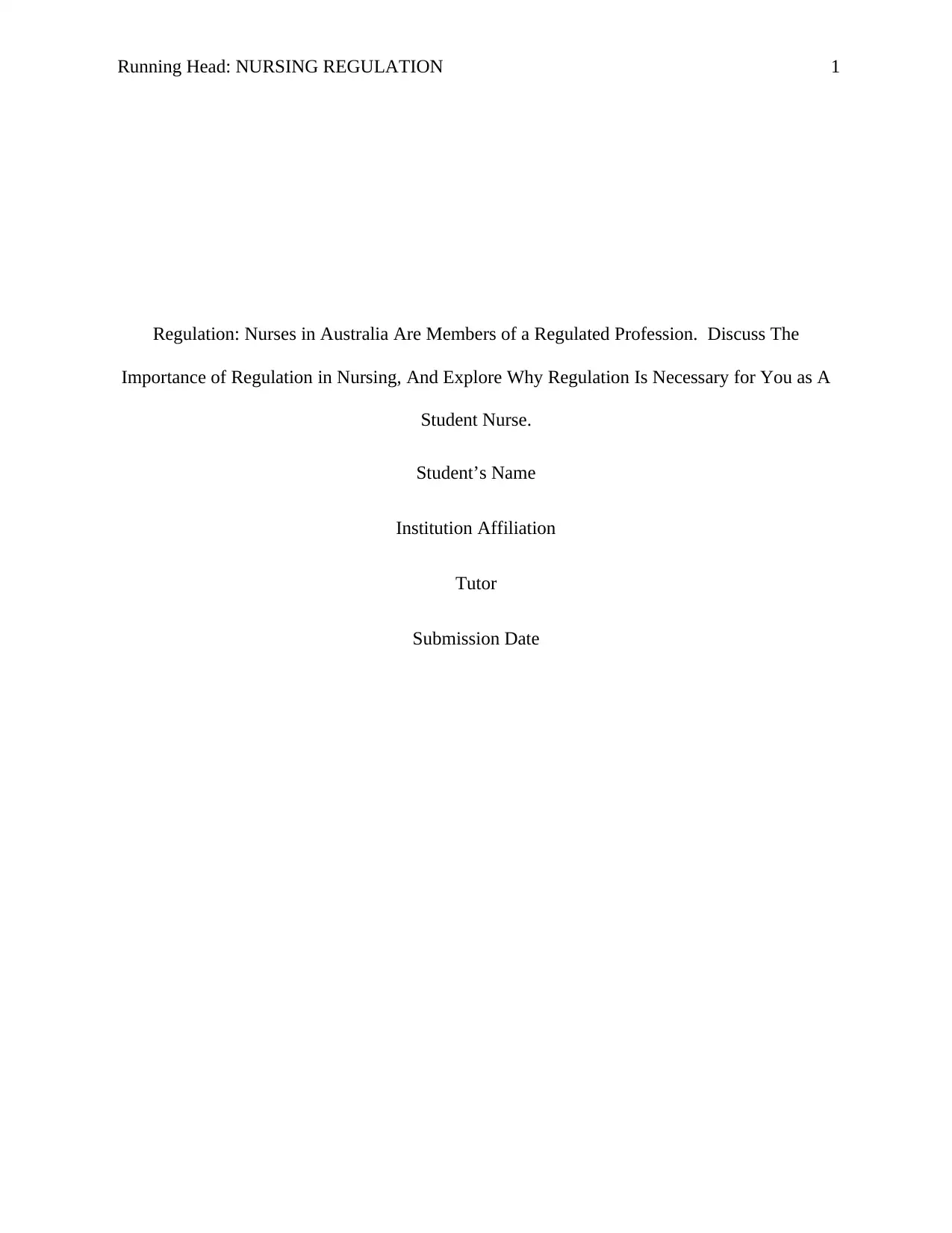
Running Head: NURSING REGULATION 1
Regulation: Nurses in Australia Are Members of a Regulated Profession. Discuss The
Importance of Regulation in Nursing, And Explore Why Regulation Is Necessary for You as A
Student Nurse.
Student’s Name
Institution Affiliation
Tutor
Submission Date
Regulation: Nurses in Australia Are Members of a Regulated Profession. Discuss The
Importance of Regulation in Nursing, And Explore Why Regulation Is Necessary for You as A
Student Nurse.
Student’s Name
Institution Affiliation
Tutor
Submission Date
Paraphrase This Document
Need a fresh take? Get an instant paraphrase of this document with our AI Paraphraser
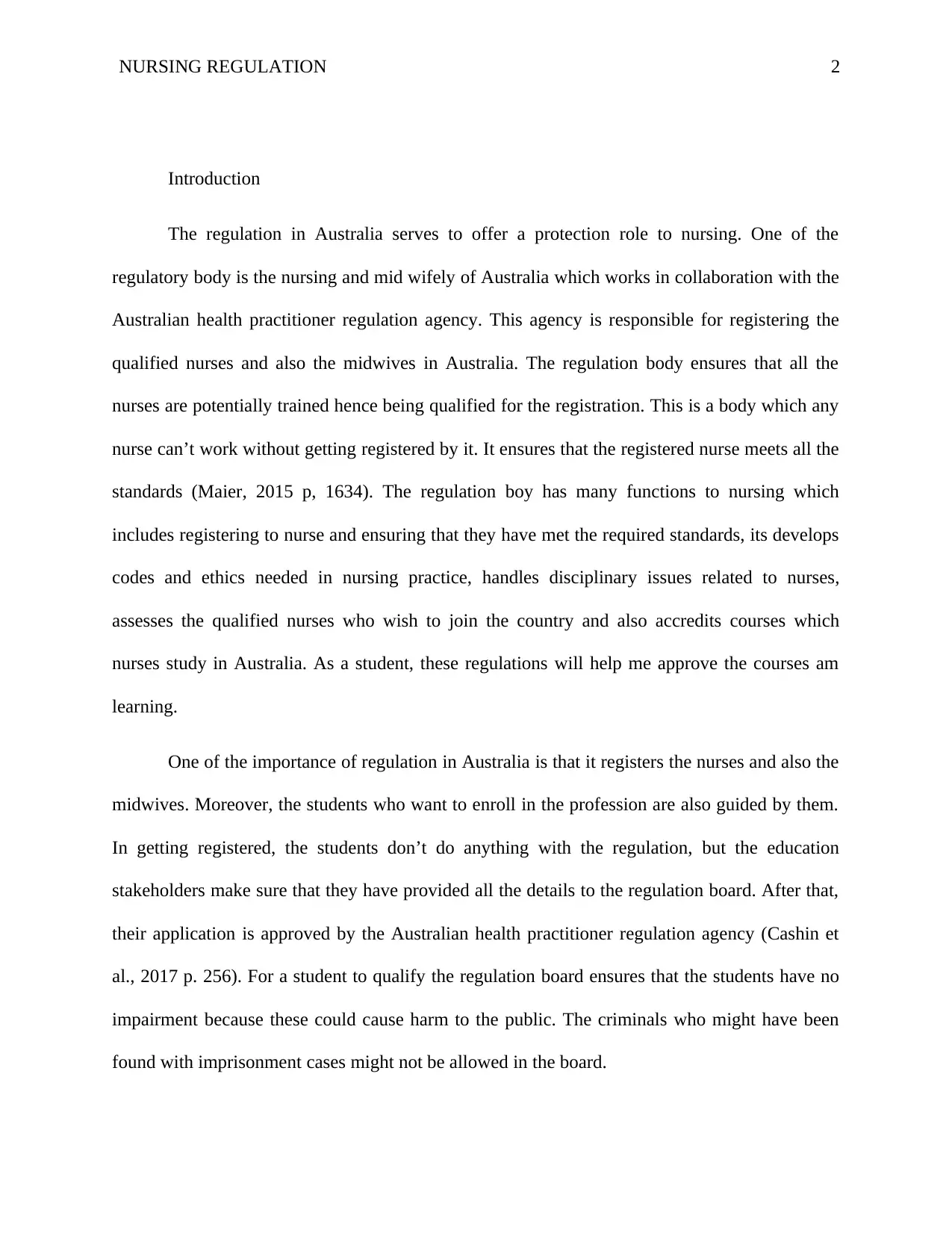
NURSING REGULATION 2
Introduction
The regulation in Australia serves to offer a protection role to nursing. One of the
regulatory body is the nursing and mid wifely of Australia which works in collaboration with the
Australian health practitioner regulation agency. This agency is responsible for registering the
qualified nurses and also the midwives in Australia. The regulation body ensures that all the
nurses are potentially trained hence being qualified for the registration. This is a body which any
nurse can’t work without getting registered by it. It ensures that the registered nurse meets all the
standards (Maier, 2015 p, 1634). The regulation boy has many functions to nursing which
includes registering to nurse and ensuring that they have met the required standards, its develops
codes and ethics needed in nursing practice, handles disciplinary issues related to nurses,
assesses the qualified nurses who wish to join the country and also accredits courses which
nurses study in Australia. As a student, these regulations will help me approve the courses am
learning.
One of the importance of regulation in Australia is that it registers the nurses and also the
midwives. Moreover, the students who want to enroll in the profession are also guided by them.
In getting registered, the students don’t do anything with the regulation, but the education
stakeholders make sure that they have provided all the details to the regulation board. After that,
their application is approved by the Australian health practitioner regulation agency (Cashin et
al., 2017 p. 256). For a student to qualify the regulation board ensures that the students have no
impairment because these could cause harm to the public. The criminals who might have been
found with imprisonment cases might not be allowed in the board.
Introduction
The regulation in Australia serves to offer a protection role to nursing. One of the
regulatory body is the nursing and mid wifely of Australia which works in collaboration with the
Australian health practitioner regulation agency. This agency is responsible for registering the
qualified nurses and also the midwives in Australia. The regulation body ensures that all the
nurses are potentially trained hence being qualified for the registration. This is a body which any
nurse can’t work without getting registered by it. It ensures that the registered nurse meets all the
standards (Maier, 2015 p, 1634). The regulation boy has many functions to nursing which
includes registering to nurse and ensuring that they have met the required standards, its develops
codes and ethics needed in nursing practice, handles disciplinary issues related to nurses,
assesses the qualified nurses who wish to join the country and also accredits courses which
nurses study in Australia. As a student, these regulations will help me approve the courses am
learning.
One of the importance of regulation in Australia is that it registers the nurses and also the
midwives. Moreover, the students who want to enroll in the profession are also guided by them.
In getting registered, the students don’t do anything with the regulation, but the education
stakeholders make sure that they have provided all the details to the regulation board. After that,
their application is approved by the Australian health practitioner regulation agency (Cashin et
al., 2017 p. 256). For a student to qualify the regulation board ensures that the students have no
impairment because these could cause harm to the public. The criminals who might have been
found with imprisonment cases might not be allowed in the board.
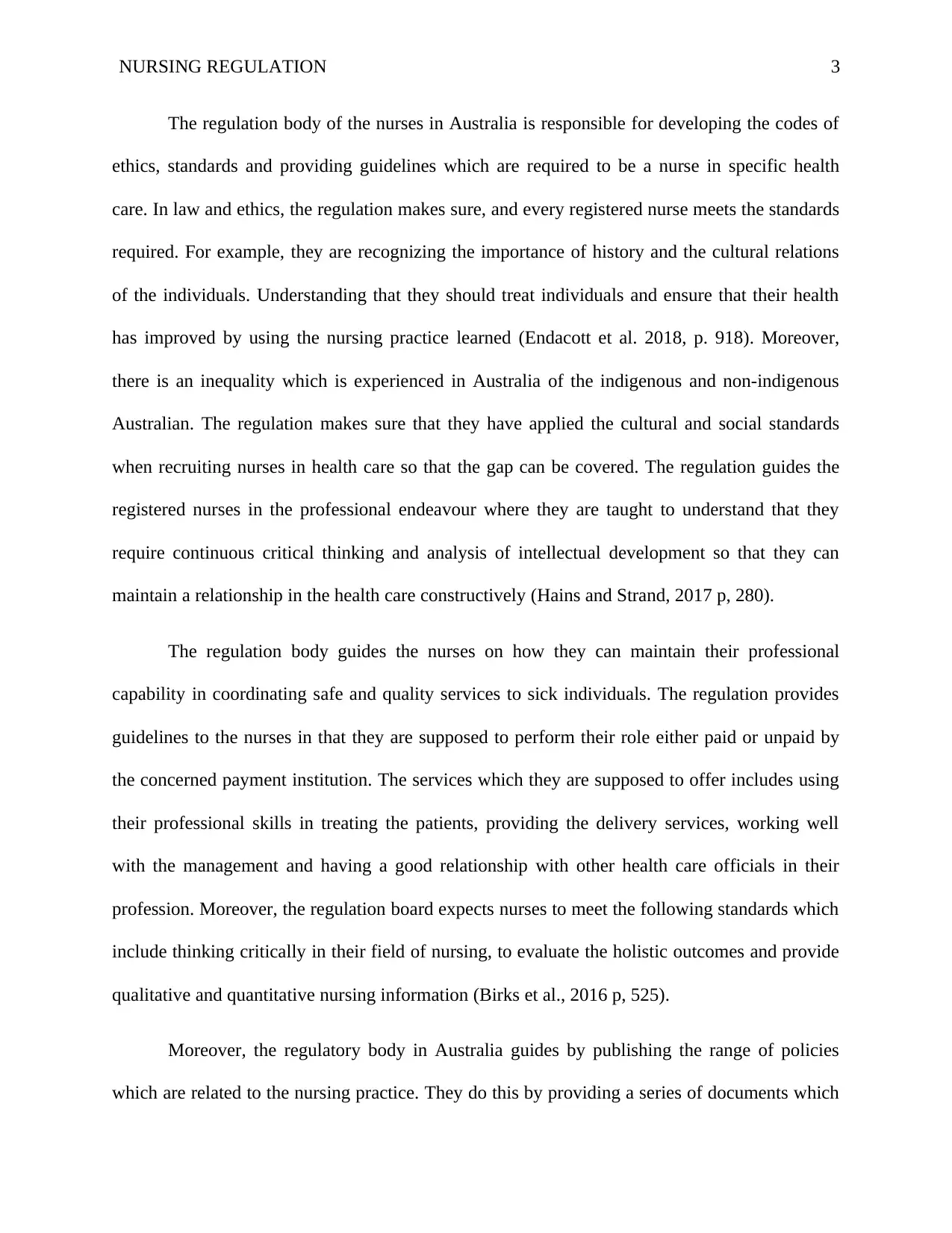
NURSING REGULATION 3
The regulation body of the nurses in Australia is responsible for developing the codes of
ethics, standards and providing guidelines which are required to be a nurse in specific health
care. In law and ethics, the regulation makes sure, and every registered nurse meets the standards
required. For example, they are recognizing the importance of history and the cultural relations
of the individuals. Understanding that they should treat individuals and ensure that their health
has improved by using the nursing practice learned (Endacott et al. 2018, p. 918). Moreover,
there is an inequality which is experienced in Australia of the indigenous and non-indigenous
Australian. The regulation makes sure that they have applied the cultural and social standards
when recruiting nurses in health care so that the gap can be covered. The regulation guides the
registered nurses in the professional endeavour where they are taught to understand that they
require continuous critical thinking and analysis of intellectual development so that they can
maintain a relationship in the health care constructively (Hains and Strand, 2017 p, 280).
The regulation body guides the nurses on how they can maintain their professional
capability in coordinating safe and quality services to sick individuals. The regulation provides
guidelines to the nurses in that they are supposed to perform their role either paid or unpaid by
the concerned payment institution. The services which they are supposed to offer includes using
their professional skills in treating the patients, providing the delivery services, working well
with the management and having a good relationship with other health care officials in their
profession. Moreover, the regulation board expects nurses to meet the following standards which
include thinking critically in their field of nursing, to evaluate the holistic outcomes and provide
qualitative and quantitative nursing information (Birks et al., 2016 p, 525).
Moreover, the regulatory body in Australia guides by publishing the range of policies
which are related to the nursing practice. They do this by providing a series of documents which
The regulation body of the nurses in Australia is responsible for developing the codes of
ethics, standards and providing guidelines which are required to be a nurse in specific health
care. In law and ethics, the regulation makes sure, and every registered nurse meets the standards
required. For example, they are recognizing the importance of history and the cultural relations
of the individuals. Understanding that they should treat individuals and ensure that their health
has improved by using the nursing practice learned (Endacott et al. 2018, p. 918). Moreover,
there is an inequality which is experienced in Australia of the indigenous and non-indigenous
Australian. The regulation makes sure that they have applied the cultural and social standards
when recruiting nurses in health care so that the gap can be covered. The regulation guides the
registered nurses in the professional endeavour where they are taught to understand that they
require continuous critical thinking and analysis of intellectual development so that they can
maintain a relationship in the health care constructively (Hains and Strand, 2017 p, 280).
The regulation body guides the nurses on how they can maintain their professional
capability in coordinating safe and quality services to sick individuals. The regulation provides
guidelines to the nurses in that they are supposed to perform their role either paid or unpaid by
the concerned payment institution. The services which they are supposed to offer includes using
their professional skills in treating the patients, providing the delivery services, working well
with the management and having a good relationship with other health care officials in their
profession. Moreover, the regulation board expects nurses to meet the following standards which
include thinking critically in their field of nursing, to evaluate the holistic outcomes and provide
qualitative and quantitative nursing information (Birks et al., 2016 p, 525).
Moreover, the regulatory body in Australia guides by publishing the range of policies
which are related to the nursing practice. They do this by providing a series of documents which
⊘ This is a preview!⊘
Do you want full access?
Subscribe today to unlock all pages.

Trusted by 1+ million students worldwide
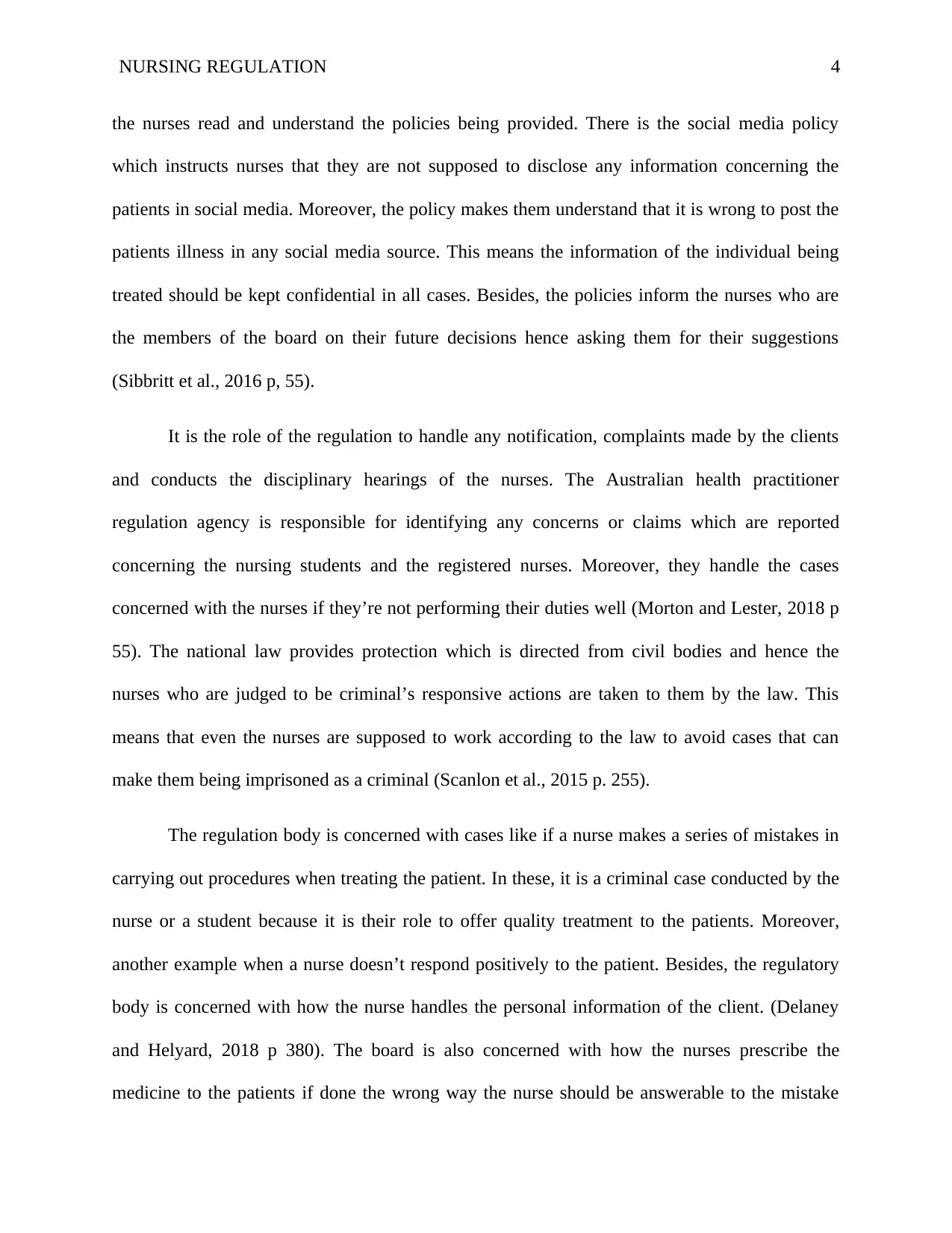
NURSING REGULATION 4
the nurses read and understand the policies being provided. There is the social media policy
which instructs nurses that they are not supposed to disclose any information concerning the
patients in social media. Moreover, the policy makes them understand that it is wrong to post the
patients illness in any social media source. This means the information of the individual being
treated should be kept confidential in all cases. Besides, the policies inform the nurses who are
the members of the board on their future decisions hence asking them for their suggestions
(Sibbritt et al., 2016 p, 55).
It is the role of the regulation to handle any notification, complaints made by the clients
and conducts the disciplinary hearings of the nurses. The Australian health practitioner
regulation agency is responsible for identifying any concerns or claims which are reported
concerning the nursing students and the registered nurses. Moreover, they handle the cases
concerned with the nurses if they’re not performing their duties well (Morton and Lester, 2018 p
55). The national law provides protection which is directed from civil bodies and hence the
nurses who are judged to be criminal’s responsive actions are taken to them by the law. This
means that even the nurses are supposed to work according to the law to avoid cases that can
make them being imprisoned as a criminal (Scanlon et al., 2015 p. 255).
The regulation body is concerned with cases like if a nurse makes a series of mistakes in
carrying out procedures when treating the patient. In these, it is a criminal case conducted by the
nurse or a student because it is their role to offer quality treatment to the patients. Moreover,
another example when a nurse doesn’t respond positively to the patient. Besides, the regulatory
body is concerned with how the nurse handles the personal information of the client. (Delaney
and Helyard, 2018 p 380). The board is also concerned with how the nurses prescribe the
medicine to the patients if done the wrong way the nurse should be answerable to the mistake
the nurses read and understand the policies being provided. There is the social media policy
which instructs nurses that they are not supposed to disclose any information concerning the
patients in social media. Moreover, the policy makes them understand that it is wrong to post the
patients illness in any social media source. This means the information of the individual being
treated should be kept confidential in all cases. Besides, the policies inform the nurses who are
the members of the board on their future decisions hence asking them for their suggestions
(Sibbritt et al., 2016 p, 55).
It is the role of the regulation to handle any notification, complaints made by the clients
and conducts the disciplinary hearings of the nurses. The Australian health practitioner
regulation agency is responsible for identifying any concerns or claims which are reported
concerning the nursing students and the registered nurses. Moreover, they handle the cases
concerned with the nurses if they’re not performing their duties well (Morton and Lester, 2018 p
55). The national law provides protection which is directed from civil bodies and hence the
nurses who are judged to be criminal’s responsive actions are taken to them by the law. This
means that even the nurses are supposed to work according to the law to avoid cases that can
make them being imprisoned as a criminal (Scanlon et al., 2015 p. 255).
The regulation body is concerned with cases like if a nurse makes a series of mistakes in
carrying out procedures when treating the patient. In these, it is a criminal case conducted by the
nurse or a student because it is their role to offer quality treatment to the patients. Moreover,
another example when a nurse doesn’t respond positively to the patient. Besides, the regulatory
body is concerned with how the nurse handles the personal information of the client. (Delaney
and Helyard, 2018 p 380). The board is also concerned with how the nurses prescribe the
medicine to the patients if done the wrong way the nurse should be answerable to the mistake
Paraphrase This Document
Need a fresh take? Get an instant paraphrase of this document with our AI Paraphraser
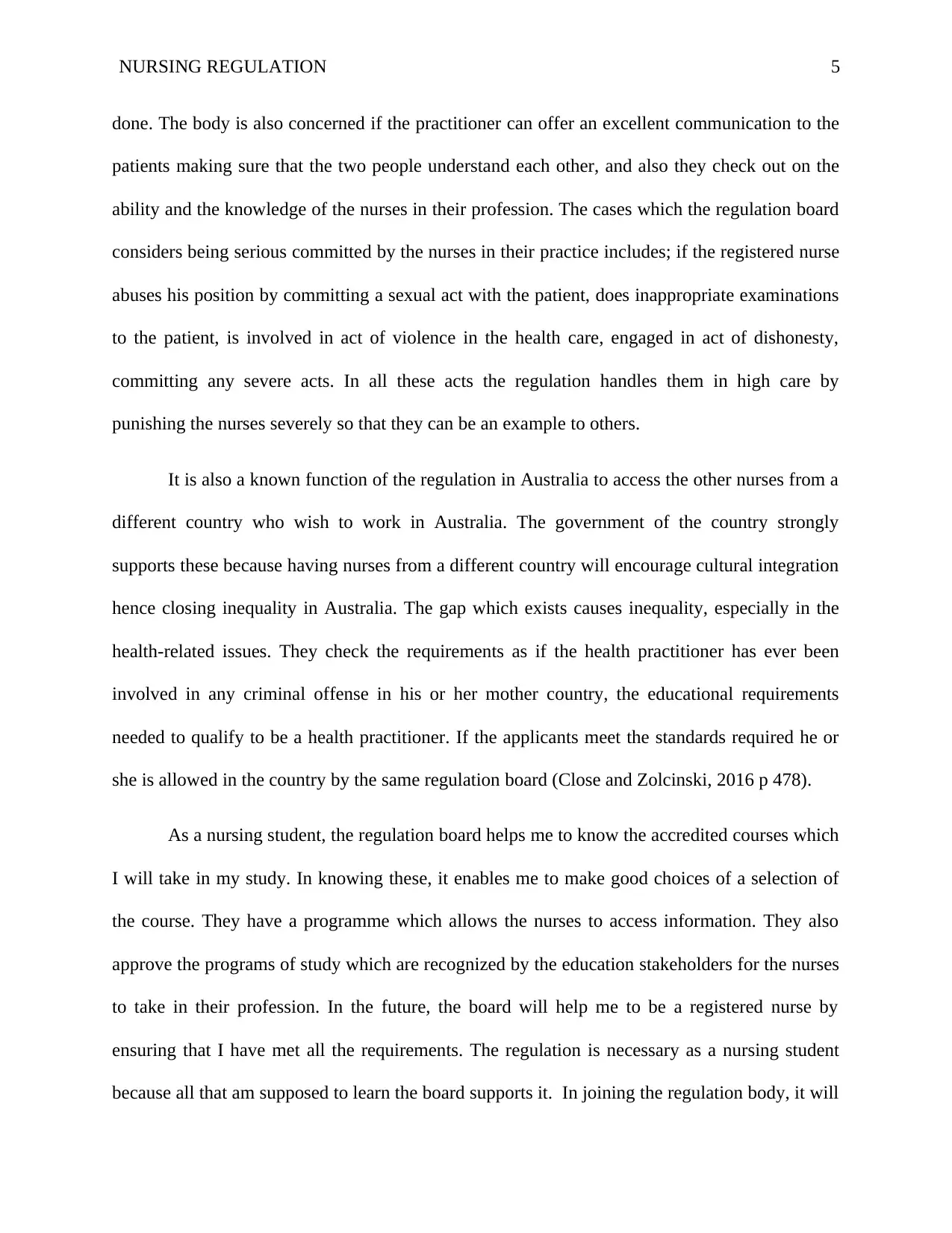
NURSING REGULATION 5
done. The body is also concerned if the practitioner can offer an excellent communication to the
patients making sure that the two people understand each other, and also they check out on the
ability and the knowledge of the nurses in their profession. The cases which the regulation board
considers being serious committed by the nurses in their practice includes; if the registered nurse
abuses his position by committing a sexual act with the patient, does inappropriate examinations
to the patient, is involved in act of violence in the health care, engaged in act of dishonesty,
committing any severe acts. In all these acts the regulation handles them in high care by
punishing the nurses severely so that they can be an example to others.
It is also a known function of the regulation in Australia to access the other nurses from a
different country who wish to work in Australia. The government of the country strongly
supports these because having nurses from a different country will encourage cultural integration
hence closing inequality in Australia. The gap which exists causes inequality, especially in the
health-related issues. They check the requirements as if the health practitioner has ever been
involved in any criminal offense in his or her mother country, the educational requirements
needed to qualify to be a health practitioner. If the applicants meet the standards required he or
she is allowed in the country by the same regulation board (Close and Zolcinski, 2016 p 478).
As a nursing student, the regulation board helps me to know the accredited courses which
I will take in my study. In knowing these, it enables me to make good choices of a selection of
the course. They have a programme which allows the nurses to access information. They also
approve the programs of study which are recognized by the education stakeholders for the nurses
to take in their profession. In the future, the board will help me to be a registered nurse by
ensuring that I have met all the requirements. The regulation is necessary as a nursing student
because all that am supposed to learn the board supports it. In joining the regulation body, it will
done. The body is also concerned if the practitioner can offer an excellent communication to the
patients making sure that the two people understand each other, and also they check out on the
ability and the knowledge of the nurses in their profession. The cases which the regulation board
considers being serious committed by the nurses in their practice includes; if the registered nurse
abuses his position by committing a sexual act with the patient, does inappropriate examinations
to the patient, is involved in act of violence in the health care, engaged in act of dishonesty,
committing any severe acts. In all these acts the regulation handles them in high care by
punishing the nurses severely so that they can be an example to others.
It is also a known function of the regulation in Australia to access the other nurses from a
different country who wish to work in Australia. The government of the country strongly
supports these because having nurses from a different country will encourage cultural integration
hence closing inequality in Australia. The gap which exists causes inequality, especially in the
health-related issues. They check the requirements as if the health practitioner has ever been
involved in any criminal offense in his or her mother country, the educational requirements
needed to qualify to be a health practitioner. If the applicants meet the standards required he or
she is allowed in the country by the same regulation board (Close and Zolcinski, 2016 p 478).
As a nursing student, the regulation board helps me to know the accredited courses which
I will take in my study. In knowing these, it enables me to make good choices of a selection of
the course. They have a programme which allows the nurses to access information. They also
approve the programs of study which are recognized by the education stakeholders for the nurses
to take in their profession. In the future, the board will help me to be a registered nurse by
ensuring that I have met all the requirements. The regulation is necessary as a nursing student
because all that am supposed to learn the board supports it. In joining the regulation body, it will
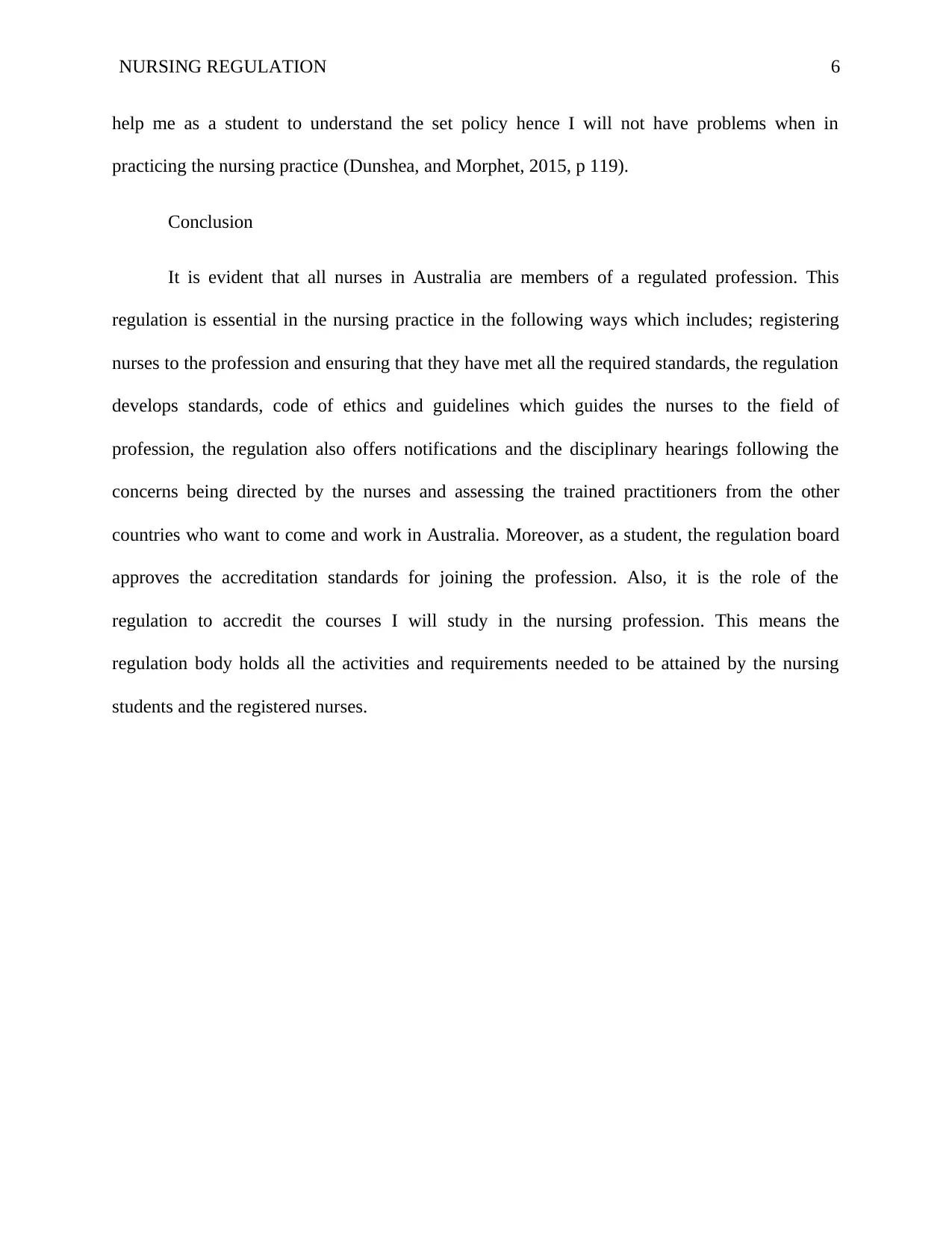
NURSING REGULATION 6
help me as a student to understand the set policy hence I will not have problems when in
practicing the nursing practice (Dunshea, and Morphet, 2015, p 119).
Conclusion
It is evident that all nurses in Australia are members of a regulated profession. This
regulation is essential in the nursing practice in the following ways which includes; registering
nurses to the profession and ensuring that they have met all the required standards, the regulation
develops standards, code of ethics and guidelines which guides the nurses to the field of
profession, the regulation also offers notifications and the disciplinary hearings following the
concerns being directed by the nurses and assessing the trained practitioners from the other
countries who want to come and work in Australia. Moreover, as a student, the regulation board
approves the accreditation standards for joining the profession. Also, it is the role of the
regulation to accredit the courses I will study in the nursing profession. This means the
regulation body holds all the activities and requirements needed to be attained by the nursing
students and the registered nurses.
help me as a student to understand the set policy hence I will not have problems when in
practicing the nursing practice (Dunshea, and Morphet, 2015, p 119).
Conclusion
It is evident that all nurses in Australia are members of a regulated profession. This
regulation is essential in the nursing practice in the following ways which includes; registering
nurses to the profession and ensuring that they have met all the required standards, the regulation
develops standards, code of ethics and guidelines which guides the nurses to the field of
profession, the regulation also offers notifications and the disciplinary hearings following the
concerns being directed by the nurses and assessing the trained practitioners from the other
countries who want to come and work in Australia. Moreover, as a student, the regulation board
approves the accreditation standards for joining the profession. Also, it is the role of the
regulation to accredit the courses I will study in the nursing profession. This means the
regulation body holds all the activities and requirements needed to be attained by the nursing
students and the registered nurses.
⊘ This is a preview!⊘
Do you want full access?
Subscribe today to unlock all pages.

Trusted by 1+ million students worldwide
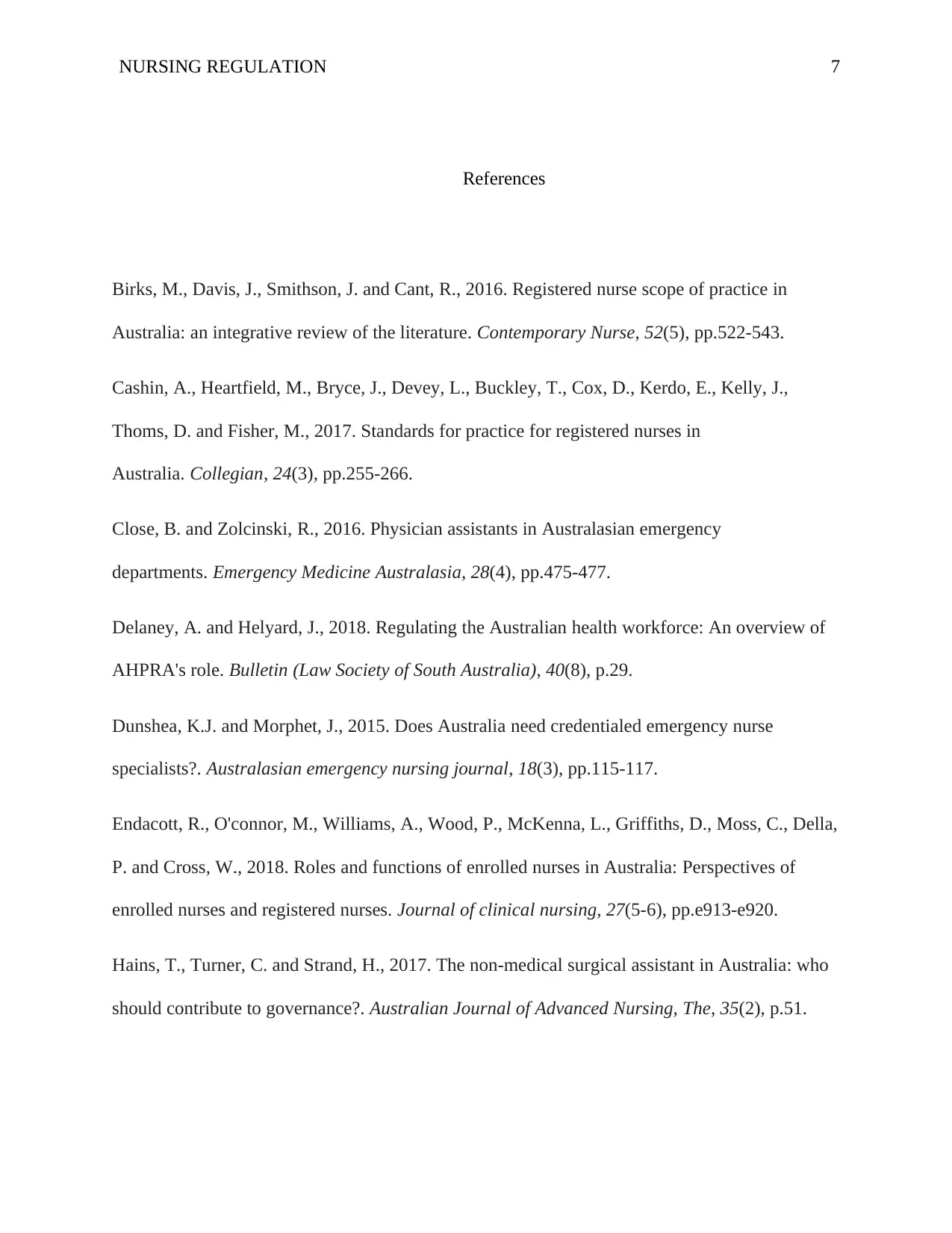
NURSING REGULATION 7
References
Birks, M., Davis, J., Smithson, J. and Cant, R., 2016. Registered nurse scope of practice in
Australia: an integrative review of the literature. Contemporary Nurse, 52(5), pp.522-543.
Cashin, A., Heartfield, M., Bryce, J., Devey, L., Buckley, T., Cox, D., Kerdo, E., Kelly, J.,
Thoms, D. and Fisher, M., 2017. Standards for practice for registered nurses in
Australia. Collegian, 24(3), pp.255-266.
Close, B. and Zolcinski, R., 2016. Physician assistants in Australasian emergency
departments. Emergency Medicine Australasia, 28(4), pp.475-477.
Delaney, A. and Helyard, J., 2018. Regulating the Australian health workforce: An overview of
AHPRA's role. Bulletin (Law Society of South Australia), 40(8), p.29.
Dunshea, K.J. and Morphet, J., 2015. Does Australia need credentialed emergency nurse
specialists?. Australasian emergency nursing journal, 18(3), pp.115-117.
Endacott, R., O'connor, M., Williams, A., Wood, P., McKenna, L., Griffiths, D., Moss, C., Della,
P. and Cross, W., 2018. Roles and functions of enrolled nurses in Australia: Perspectives of
enrolled nurses and registered nurses. Journal of clinical nursing, 27(5-6), pp.e913-e920.
Hains, T., Turner, C. and Strand, H., 2017. The non-medical surgical assistant in Australia: who
should contribute to governance?. Australian Journal of Advanced Nursing, The, 35(2), p.51.
References
Birks, M., Davis, J., Smithson, J. and Cant, R., 2016. Registered nurse scope of practice in
Australia: an integrative review of the literature. Contemporary Nurse, 52(5), pp.522-543.
Cashin, A., Heartfield, M., Bryce, J., Devey, L., Buckley, T., Cox, D., Kerdo, E., Kelly, J.,
Thoms, D. and Fisher, M., 2017. Standards for practice for registered nurses in
Australia. Collegian, 24(3), pp.255-266.
Close, B. and Zolcinski, R., 2016. Physician assistants in Australasian emergency
departments. Emergency Medicine Australasia, 28(4), pp.475-477.
Delaney, A. and Helyard, J., 2018. Regulating the Australian health workforce: An overview of
AHPRA's role. Bulletin (Law Society of South Australia), 40(8), p.29.
Dunshea, K.J. and Morphet, J., 2015. Does Australia need credentialed emergency nurse
specialists?. Australasian emergency nursing journal, 18(3), pp.115-117.
Endacott, R., O'connor, M., Williams, A., Wood, P., McKenna, L., Griffiths, D., Moss, C., Della,
P. and Cross, W., 2018. Roles and functions of enrolled nurses in Australia: Perspectives of
enrolled nurses and registered nurses. Journal of clinical nursing, 27(5-6), pp.e913-e920.
Hains, T., Turner, C. and Strand, H., 2017. The non-medical surgical assistant in Australia: who
should contribute to governance?. Australian Journal of Advanced Nursing, The, 35(2), p.51.
Paraphrase This Document
Need a fresh take? Get an instant paraphrase of this document with our AI Paraphraser
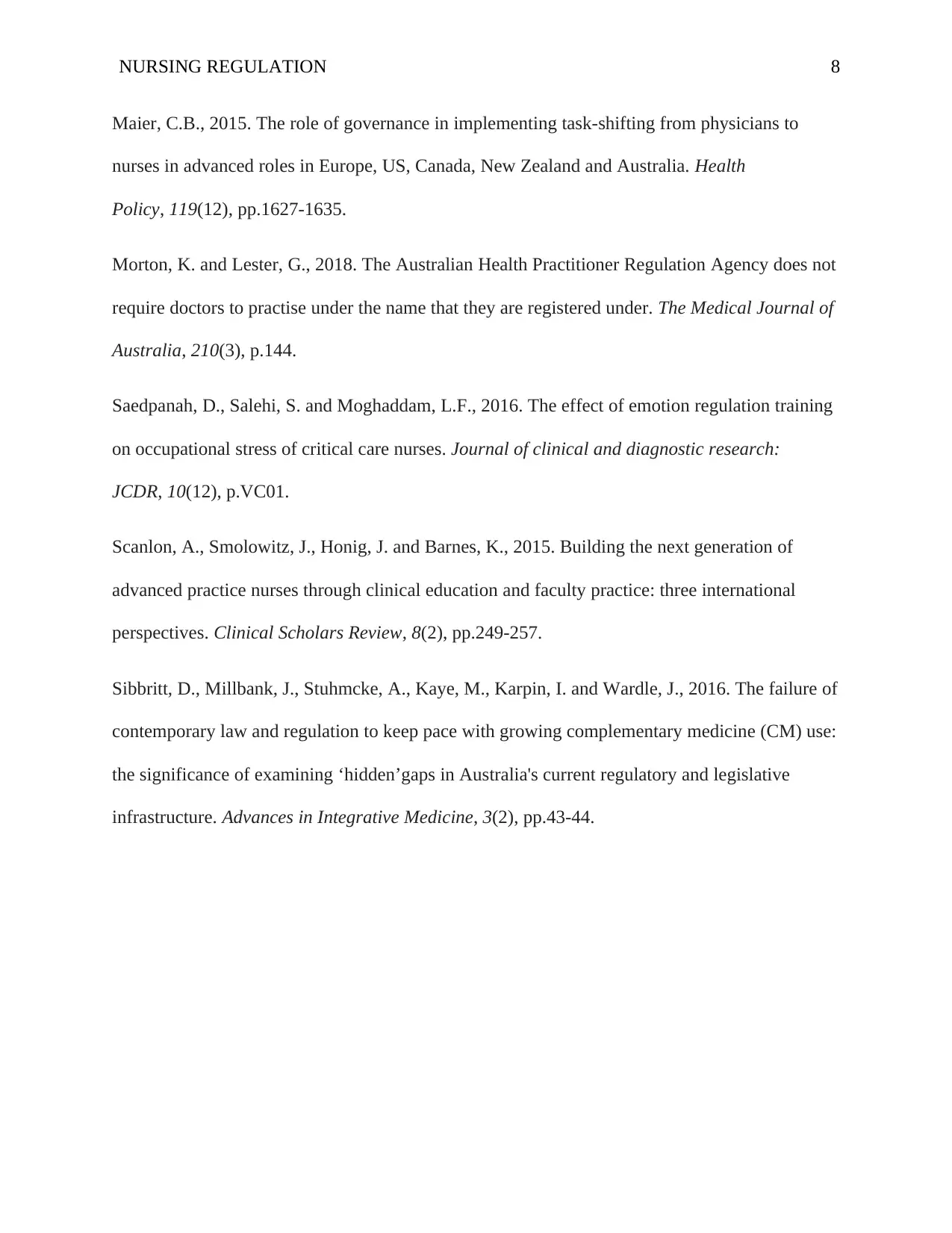
NURSING REGULATION 8
Maier, C.B., 2015. The role of governance in implementing task-shifting from physicians to
nurses in advanced roles in Europe, US, Canada, New Zealand and Australia. Health
Policy, 119(12), pp.1627-1635.
Morton, K. and Lester, G., 2018. The Australian Health Practitioner Regulation Agency does not
require doctors to practise under the name that they are registered under. The Medical Journal of
Australia, 210(3), p.144.
Saedpanah, D., Salehi, S. and Moghaddam, L.F., 2016. The effect of emotion regulation training
on occupational stress of critical care nurses. Journal of clinical and diagnostic research:
JCDR, 10(12), p.VC01.
Scanlon, A., Smolowitz, J., Honig, J. and Barnes, K., 2015. Building the next generation of
advanced practice nurses through clinical education and faculty practice: three international
perspectives. Clinical Scholars Review, 8(2), pp.249-257.
Sibbritt, D., Millbank, J., Stuhmcke, A., Kaye, M., Karpin, I. and Wardle, J., 2016. The failure of
contemporary law and regulation to keep pace with growing complementary medicine (CM) use:
the significance of examining ‘hidden’gaps in Australia's current regulatory and legislative
infrastructure. Advances in Integrative Medicine, 3(2), pp.43-44.
Maier, C.B., 2015. The role of governance in implementing task-shifting from physicians to
nurses in advanced roles in Europe, US, Canada, New Zealand and Australia. Health
Policy, 119(12), pp.1627-1635.
Morton, K. and Lester, G., 2018. The Australian Health Practitioner Regulation Agency does not
require doctors to practise under the name that they are registered under. The Medical Journal of
Australia, 210(3), p.144.
Saedpanah, D., Salehi, S. and Moghaddam, L.F., 2016. The effect of emotion regulation training
on occupational stress of critical care nurses. Journal of clinical and diagnostic research:
JCDR, 10(12), p.VC01.
Scanlon, A., Smolowitz, J., Honig, J. and Barnes, K., 2015. Building the next generation of
advanced practice nurses through clinical education and faculty practice: three international
perspectives. Clinical Scholars Review, 8(2), pp.249-257.
Sibbritt, D., Millbank, J., Stuhmcke, A., Kaye, M., Karpin, I. and Wardle, J., 2016. The failure of
contemporary law and regulation to keep pace with growing complementary medicine (CM) use:
the significance of examining ‘hidden’gaps in Australia's current regulatory and legislative
infrastructure. Advances in Integrative Medicine, 3(2), pp.43-44.
1 out of 8
Related Documents
Your All-in-One AI-Powered Toolkit for Academic Success.
+13062052269
info@desklib.com
Available 24*7 on WhatsApp / Email
![[object Object]](/_next/static/media/star-bottom.7253800d.svg)
Unlock your academic potential
Copyright © 2020–2025 A2Z Services. All Rights Reserved. Developed and managed by ZUCOL.





